Chapter Two
How will we manufacture materials?
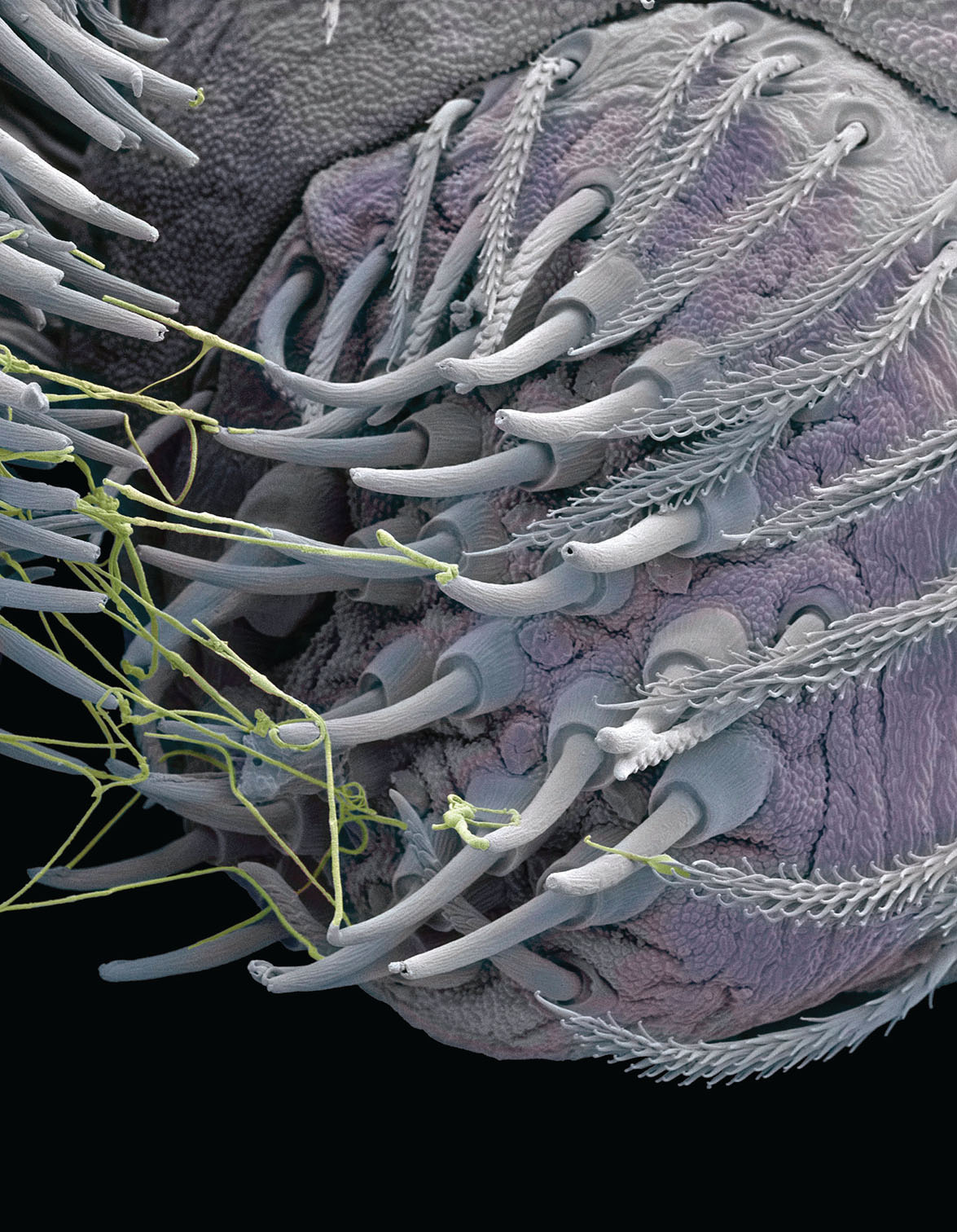
69. Spinneret glands on the abdomen of a spider from which a fibre is spun that is tougher than steel but made with a fraction of the energy
This chapter is all about assembly: using the right elements and putting them together in the right way. Let’s first look at some contrasts between the way biology assembles, and what this offers in preference to what Janine Benyus describes as the ‘heat, beat and treat’ way we conventionally manufacture.58
To produce strong fibre, spiders make their silk with an array of spinnerets59 that produce an aligned stream of polymers which are then ‘spun’ into a thread with the spider’s back legs. When dry, the silk is stronger than Kevlar (aramid fibre by another name and, prior to graphene, the strongest synthetic fibre that we have been able to manufacture to date60). Human manufacturing of aramid fibre requires petroleum to be boiled in sulphuric acid at around 750 °C. The mixture is then subjected to high pressure to get the molecules into place, producing large quantities of toxic waste. Yet spiders manage to do the same at ambient temperature and pressure with raw materials of dead flies and water. How can nature coach us to bridge this gap between contrasting manufacturing methods?
Aramid fibre exemplifies the contrast between natural and engineering mentalities. Its first lesson is to examine our expectations about materials. Our manufacturing methods typically start with energy-intensive mining, crushing, smelting, refining and forming. The process then frequently continues with other stages of treatments, protective coatings and adhesives. This intensive treatment differs, unfavourably, from the manufacturing that goes on in nature. Given our existing challenges of resource depletion, an expanding population and climate change, it seems a worthy goal to try to emulate nature’s efficiency in our manufacturing processes.
Our use of resources can be characterised as linear, wasteful and polluting, whereas in nature resources are maintained in closed-loop cycles. Our processes regularly produce toxic emissions, which can persist in the environment indefinitely; in the few circumstances in which toxins are used in biology, they biodegrade soon after they have served their specific purposes.
What elements should be used? The differences between engineering and nature become even clearer when one looks at which elements of the periodic table are used in the two approaches. Roughly 96 per cent of all living matter is made from four elements: carbon, oxygen, hydrogen and nitrogen. A further seven elements constitute nearly all of the remaining 4 per cent: calcium, phosphorous, potassium, sulphur, sodium, chlorine and magnesium. There are then a small number of trace elements that are used in absolutely minute quantities. So, nature uses a very limited subset of the periodic table, whereas we use virtually every element in existence, including some that really would be better left in the laboratory.
Emphasising the idea of assembling the right materials in the right ways, Professor Julian Vincent has described how, with just proteins, polysaccharides and some salts (mostly of calcium), nature has formed materials that have many of the same properties as human-made ones, stretching from polymers through to high-strength composites.61 While there are some metals included within the trace elements referred to above (many of which are critical to various biological processes), living organisms do not actually make anything out of metals.62 Some might argue that the only truly sustainable materials are ones that can be grown and recycled through biodegradation. For me, that is an extreme position: just because nature does not make things from, say, aluminium does not mean that we shouldn’t. However, what we can do is to apply some of the principles of resource stewardship found in nature to some of the metals and minerals that are safe to use. We may also find that there are biomimicry-inspired alternatives for many of the applications for which we currently use metals, and that those alternatives would involve a fraction of the manufacturing energy and environmental impacts.
Can we learn to manufacture in the same way that nature does?
There are seven key distinctions to guide biomimetic thinking, summarised below:63

These principles form the structure of this chapter. What do these principles imply for mimicking biological manufacture?
How nature builds: hierarchy and interfaces
Structure and materials are indistinguishable in nature, which is a radically different way of thinking to grasp in an architectural context, where these concerns are more easily separated, and where traditional manufacturing techniques and drawing packages both reinforce this separation. Nature organises structure and materials together through hierarchy.
Perhaps a good way to begin exploring hierarchy is to visualise a range of bridge designs. One means of spanning a modest distance would be to use two solid steel beams that sit on piers at either end. This would represent a monolithic approach with no hierarchy. A more efficient way to span the distance would be to use a pair of steel trusses instead. That represents one level of hierarchy. Supposing we went one step further so that each compression member in the truss became a small box truss and each tension member became a cable made from stranded steel. That would represent two levels of hierarchy. With increasing levels of hierarchy, the structure becomes more efficient in terms of the amount of material used to achieve a given objective (fig. 70).
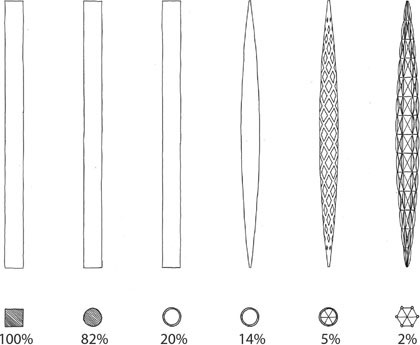
70.
Diagram showing how, with levels of hierarchy, an element of structure can be further refined to use as little as 2 per cent of the material of a solid section (after work by Adriaan Beukers and Ed van Hinte in Lightness: The Inevitable Renaissance of Minimum Energy Structures,64 with input from Fluid Structures)

71. Trusses within trusses within trusses on the Eiffel Tower – showing three levels of hierarchy
The Eiffel Tower (fig. 71) demonstrates three levels of hierarchy, but the majority of human engineering uses only one level. In biology, it is not uncommon to find six levels of hierarchy and proportionately higher performance because the structure benefits from bonds at every level from atoms to molecules to cells to organisms and upwards.65
The bridge example shows the material decreasing in quantity and changing form at the same time (solid steel sections become steel cable). At this point some readers may be feeling confused about the difference between structures and materials and that is quite justifiable because in biology there really is no distinction between the two. The way that nature makes things from the bottom up, molecule by molecule, means that what we might think of as a biological material is also a structure. Wood (fig. 72), for instance, is a microstructure of lignified cell walls, and bone (fig. 73) is a hierarchical structure of calcium phosphate and collagen molecules in fibrous, laminar, particulate and porous form.
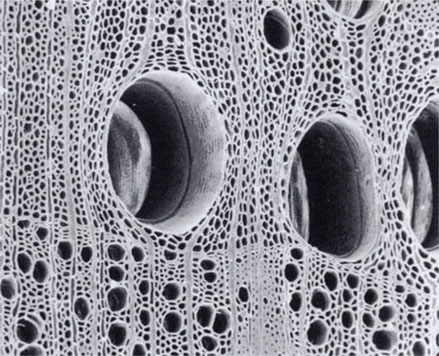
72.
Scanning electron micrograph showing the microstructure of oak (Quercus robar)

73.
Scanning electron micrograph of cancellous (spongy) bone tissue
Hierarchical structures also deliver benefits in stiffness and fracture control and this is achieved through interfaces between, and within, each level of hierarchy. The abalone shell (see Chapter 1) is made from platelets of aragonite (a form of calcium carbonate) bonded together with a flexible polymer mortar. The polymer forms the interface and, as is typical in biology, the material used at these points is weaker than the surrounding material. Materials scientist J. E. Gordon explains: ‘this is not because Nature is too incompetent to glue them together properly but because, properly contrived, the weak interfaces strengthen the material and make it tough’.66 Toughness, in engineering terms, means resistance to fracture. Although 95 per cent of an abalone shell is made from the same raw material as chalk, it achieves 3,000 times the toughness through its hierarchical structure and interfaces. Artificial nacre is already being constructed, with research aiming to create ceramic materials and composites with far greater strength than has conventionally been possible.67 Currently, these experiments are at relatively small scale (by architects’ standards, that is – an abalone would take the opposite view) but could lead to substantial increases in spanning capabilities of Guastavino vaulting and related forms of construction.
The previous chapter described the macro-structure of Euplectella; its microstructure is also worthy of study because each spicule is a hierarchical structure in itself.
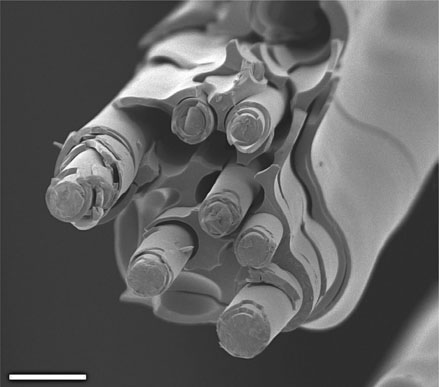
74.
Scanning electron micrograph showing the hierarchical structure of glass sponge spicules
Professor Joanna Aizenberg has revealed the way that the spicules are built up in layers of silica of gradually increasing thickness towards a central cylinder (fig. 74). Each of the layers is joined with a thin interface of protein which results in a robustness similar to that of nacre. As Aizenberg describes it: ‘During mechanical loading, the thin outer layers fracture first, resulting in the dissipation of large quantities of energy primarily via the spreading of cracks through the delamination of the silica layers.’68 The glass sponge has evolved to grow these remarkable structures at ambient temperature and pressure. Aizenberg’s work points the way towards low-energy manufacturing of high-performance composites.
Growth by adaptive accretion and additive manufacturing
Nano-scale self-assembly is crucial to how nature operates. Molecular self-assembly in nature is the process by which molecules take on an ordered arrangement without external guidance or management, and also by which they fold into macromolecular assemblies. A major opportunity to mimic this is the prospect of growing materials for buildings by accretion or self-assembly that mimics natural processes. Initially called ‘rapid prototyping’ or ‘rapid manufacturing’ (RM), now generally referred to as ‘3D printing’ or ‘additive manufacturing’ (AM), it was a significant breakthrough for designers in the digital revolution because it allows a three-dimensional computer model to be turned directly into a physical model with a very high degree of accuracy and without the laborious process of making a prototype by conventional means. Coincidentally, what AM also allows is to approximate the bottom-up manufacturing that goes on in nature, in the way that material can be positioned exactly where it needs to be. Consequently, it offers the ability to achieve efficiency of materials through complexity of form at no added cost – in fact, it can achieve lower costs simply by using less material.69
The designer and authority on AM, Geoff Hollington, has asserted that the technology now challenges the three traditional ways of making things that have been used since antiquity. The old methods can be summarised as ‘subtractive’ (such as shaping flint, carving wood or modern machining), ‘moulding’ (clay pottery, cast metal or moulded plastic) and ‘forming’ (bending, forging and stamping).70 New approaches will pioneer additive approaches that approximate the molecular, from-the-bottom-up, manufacturing that occurs in biology.
Machines now exist that allow mixed materials, as nanoparticles in solution, to be deposited from a jet that is similar to that of an inkjet printer. The very small scale of the material allows low-energy bonds, such as van der Waals forces, to assist in assembling the particles. If one material that cures to a hard finish is used in combination with another material that dries in a flexible form, then it is possible to produce an element that can be either very tough (exploiting the interfaces), very flexible, or even varying in these properties along its length (referred to as ‘functionally graded materials’) (fig. 75). While we have yet to achieve equivalent technology to biological growth processes, we are getting tantalisingly close.

75. Pneuma by Neri Oxman, demonstrating the potential for 3D printing to produce functionally graded materials in complex forms
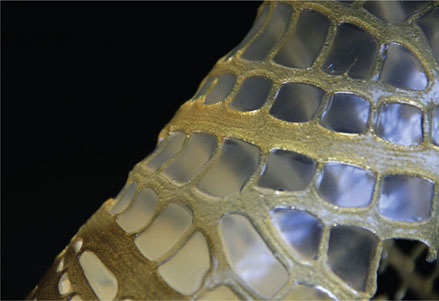
76.
Chitosan structure 3D printed with biological raw materials by Neri Oxman and colleagues at MIT Media Lab
What should these machines print with? What we ideally want is to be able to use a biological raw material, get it to self-assemble into polymer chains and then be able to assemble those chains in a controlled way. Perhaps the closest to achieving this has been the work of Neri Oxman and colleagues at the ‘Mediated Matter’ laboratory at MIT Media Lab, who have managed to print with chitosan (a deacetylated form of chitin – one of the substances from which insect carapaces, prawn shells and crabs shells are made) and functionally graded materials with spectacular results (fig. 76). Mogas-Soldevila et al. have observed that natural polymers and polysaccharides represent a vast renewable resource and that:
Eventually, it will be possible to include interfaces and many levels of hierarchy. This could achieve a degree of resource efficiency and resilience similar to that found in many of the biological sources that will continue to be studied by collaborative teams of scientists and designers. Most, if not all, AM is carried out at ambient temperature and pressure and therefore offers the potential for much lower-energy fabrication than conventional approaches.
Another widely used natural material is cellulose. It is an underutilised resource from algal biofuel production and would be easy to extract, because algae do not cross-link the cellulose in their cell walls through lignification. Cellulose is one of the most abundant biological materials and, furthermore, nano-crystals of cellulose can be made to self-assemble into sheets and fibres.72 Taking inspiration from Buckminster Fuller’s assertion that ‘Pollution is nothing but the resources we are not harvesting’,73 we could use the blanket weed (Spirogyra) that has clogged countless lakes and rivers around the world, where agricultural fertilisers have been overused, as a further source of cellulose for additive manufacturing. At a large scale, this could be another drawdown technology that would be effectively growing materials from atmospheric carbon (with some obliging intermediaries, such as prawns, algae and insects).
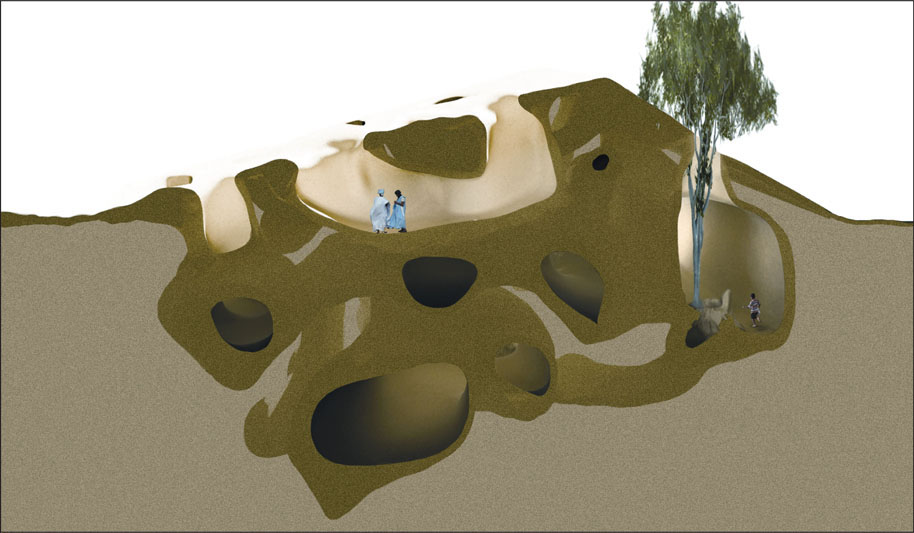
77.
‘Dune’ – Arenaceous Anti-Desertification Architecture by Magnus Larsson, which uses microbial deposition to create habitable structures within sand dunes
While AM is a form of technical self-assembly, it is also possible to employ some biological assistance. Exploring microbially grown materials is something that has now successfully reached market deployment, thanks to Ginger Krieg Dosier at biotechnology startup bioMASON. Dosier’s concept developed when studying micro-organisms in coral reefs and led on to the idea of using Sporosarcina pasteurii bacteria to bind sand with calcium carbonate. The inoculated sand is placed in moulds, fed with calcium ions and hardens into bricks in two to five days – the same amount of time as it takes to kiln-fire a conventional brick but with a fraction of the energy input.74 The architect Magnus Larsson has pursued a similar form of microbial precipitation but with the intention of forming structures in situ in desert areas (fig. 77). Experimental architectural practice The Living has explored bacterial growth as another way of literally growing materials – namely, using fungal mycelia to bind together discarded corn stalks into bricks with sufficient compressive strength to be used in construction. The firm assembled these into a temporary installation called ‘Hy-Fi’ (figs 78 & 79), the form of which is reminiscent of chopped sections of highly magnified mycelia. After dismantling, the bricks were composted and completely reabsorbed into the biological cycle. Similar schemes have been assembled by drones, such as Gramazio Kohler Architects’ ‘Flight Assembled Architecture’. It could be argued that this approach of using micro-agents to precisely position small components is getter closer to the self-assembly that occurs in biology. Despite a big difference in scale, it marks a dramatic new direction when compared to the conventional approach of large components assembled by large human agents.

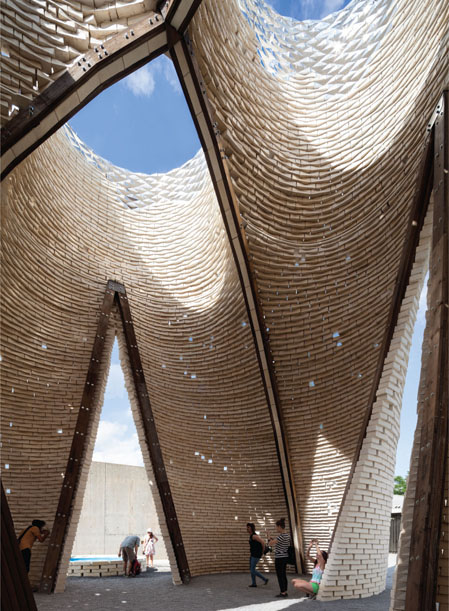
78–79. ‘Hy-Fi’ by The Living, constructed using bricks that were grown using fungal mycelia
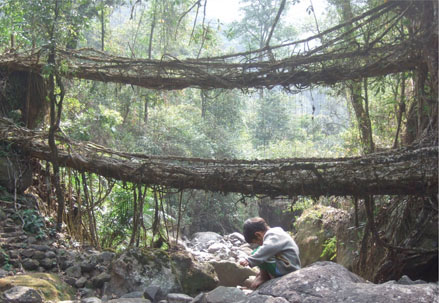
80. The living bridges of Cherrapunji – an example of a grown structure that is still alive, which would more accurately be referred to as bio-utilisation rather than biomimicry
Environmentally influenced self-assembly
Nature offers another arena to inspire current building practices: epigenesis. Epigenesis is the process by which growth is significantly influenced by the environment; it is an additional determinant of growth to genetics. A straightforward example would be the way that trees grow partly in response to the forces that act on them. A branch joining the trunk is subjected to stress in windy conditions and will grow thicker in the affected areas in response (part of Claus Mattheck’s axiom of uniform stress referred to in Chapter 1).
Because buildings generally do not yet grow in any sense that is truly comparable to biology, there are very few existing examples of epigenesis in architecture. One that comes close is the proposal for the Biorock Pavilion by Exploration, based on the technology pioneered by marine biologist Thomas J. Goreau and engineer/architect Wolf Hilbertz.75 This uses electro-deposition in seawater to form accretive mineral structures. An electrical current, low enough to be safe for marine life, is passed through a steel frame submerged in seawater, resulting in dissolved minerals being deposited on the structure. To date, the technology has only been used to restore coral reefs by growing mineral structures on which corals can become established and flourish.76

81.
The Biorock Pavilion, which is to be grown in seawater in a way that is comparable to epigenesis
The Biorock Pavilion (fig. 81) is intended to be a small auditorium that will be grown in seawater and then floated to the surface and transported to an urban location, where it will be a venue for small-scale performances. Design team member Professor Julian Vincent suggested using strain gauges to determine the amount of current supplied to each member, making the growth process epigenetic. Since the rate of accretion is partly determined77 by the current, the members that were subjected to greater strain would be the ones that would grow more in response. The rate of accretion can be as high as 50 mm per year and, depending on the speed of deposition, the compressive strength can exceed that of reinforced concrete. The minerals continue to be deposited for as long as the current passes through the frame and damaged areas will repair themselves. Offshore wind turbines could use small amounts of surplus electricity to reinforce their foundations with Biorock, or build reefs that help to restore marine ecosystems.
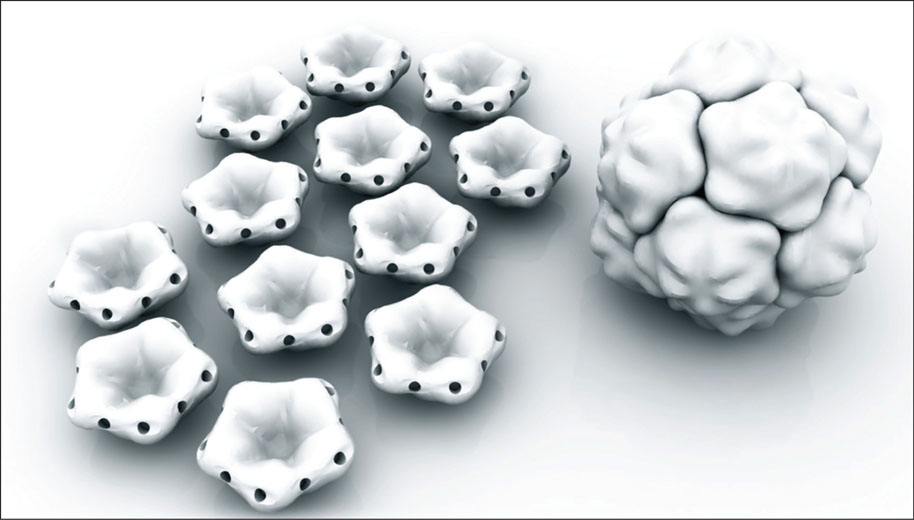
82. Bio-molecular self-assembly by Skylar Tibbits – exploring the potential for individual elements to self-organise into structures
The work of the MIT Self-Assembly Lab has explored ways in which elements can be ‘programmed’ to self-assemble into predetermined forms or self-adapt to particular conditions, often through passive forms of energy, such as ambient heat, vibration or magnetic fields. They define self-assembly as ‘a process by which disordered parts build an ordered structure through only local interaction’78 (fig. 82). The founder of the Lab, Skylar Tibbits, has proposed that one of the most useful applications of this approach would be for construction in extreme environments where it may not be safe or feasible for humans to go.
Environmental responsiveness
Materials that can sense and respond to changes in their environment are often referred to as ‘smart’. Clearly, in architecture we create many systems that do this at the level of a building and it is worth making a distinction here. In most of our systems engineering there will be a sensor, a processor and an actuator; in a truly ‘smart’ material, the sensor and actuator is the same thing and there is no processor.
One example originally studied at the Centre for Biomimetics at Reading University is the pine cone, which stays firmly closed when it is on the tree. When the pine cone falls, it starts to dry out and open up, eventually releasing the seeds inside. The opening occurs because the scales of the pine cone are sandwich structures made from two materials that react differently to humidity: one of them shrinks more than the other and the bending effect is similar to a bimetallic strip. This hygroscopic actuation was developed into a multilayered textile with lots of small flaps that would open up when the wearer started to sweat and close again when the skin beneath had cooled.
A similar idea, also inspired by pine cones, was developed into a stunning installation (fig. 83) by Achim Menges, Steffen Reichert and colleagues at the University of Stuttgart’s Institute for Computational Design using a composite of veneers that would either lie flat or roll up according to humidity levels. They describe this as ‘meteorosensitive architecture’, in the sense that it can respond directly to changes in atmospheric conditions. They make the point that ‘complex electromechanical systems have the disadvantage that they are complex to build and difficult to maintain and tend to frequently malfunction. Material embedded actuation provides a new perspective to these challenges as it intrinsically engages weather conditions’.79 The potential for facades that can control the internal environment of the building without the need for additional mechanical control is extremely appealing. Architects could develop similarly elegant responses to other environmental changes by studying examples in biology, such as the way certain leaves roll up in windy conditions, which reduces the overall wind-loading on the tree.
Self-repairing materials

83.
‘HygroScope - Meteorosensitive Morphology’, Centre Pompidou, Paris, by Achim Menges in collaboration with Steffen Reichert – materials that respond to changes in humidity without a separate sensing and processing system
As Petra Gruber has observed, self-repair is particularly useful in situations where a local failure could lead to complete system failure.80 The speed of the repair matters in such systems. Olga Speck and her team at the University of Freiburg Plant Biometrics Group have developed some ingenious self-repair solutions for pneumatic structures based on a liana called Aristolochia macrophylla. They observed that the plant rapidly heals a lesion through the expansion of thin-walled parenchymal cells adjacent to the point of damage to initially form a quick seal, and then through the more gradual repair of the tissue by lignification of the cell walls. They translated this idea into a polymer with multiple layers of pressurised cells on the underside (similar to very closely spaced bubble-wrap). When a puncture occurs, the pressurised cells react exactly like those of the liana although with even more impressive speed – the polymer can self-repair in a fraction of a second.
Self-repair is an area in which there is still a large gap between biology and engineering, simply because none of our buildings are ‘alive’ in a sense that is comparable with a living organism. Promisingly, some pioneering materials provide examples of self-repair that are analogous to biology (as opposed to having been inspired by a specific biological form of self-repair). Dr Carolyn Dry of the University of Illinois has developed a form of concrete that has adhesive-filled hollow fibres embedded into the mix so that, if a crack occurs, the fibres rupture and adhesive flows into the crack.81 Dr Henk Jonkers at the Technical University of Delft has created ‘bioconcrete’ that contains limestone-producing bacteria which are activated when a crack occurs, so that the gap is filled and the surface seal is re-established.82 Many self-repair systems in biology are dependent on vascular networks and it is conceivable that an engineered structure could be designed to have an equivalent system which delivers ‘repair liquid’ that cures in the presence of oxygen or light.
A broad definition of ‘self-repair’ includes self-cleaning materials, of which there are already several based on biomimetic ideas. Lotusan, by the paint company Sto, was named after the organism that inspired it, the lotus, which has long been revered for the way that it can grow out of the darkest mud and produce the cleanest white flowers and leaves. The effect in both the plant and the paint is delivered by means of a nano-texture of bumps which changes the contact angle of water droplets on the surface, as well as reducing the adhesion of particles, so that dirt simply rolls off with the water in the first shower of rain.83
A team at the Wyss Institute for Biologically Inspired Engineering at Harvard University has taken slipperiness to new levels by studying the pitcher plant (Nepenthes) and the result is SLIPS – an acronym for ‘Slippery Liquid-Infused Porous Surfaces’. This surface works at lower angles than the products based on the lotus effect and could be useful for a range of applications, such as anti-fouling pipe coatings and self-cleaning surfaces for photovoltaic panels.84 SLIPS uses a matrix of Teflon nanofibres in combination with a lubricant liquid so, like the pitcher plant, it is a self-repairing surface. Nature’s essential principle is ‘materials, not finishes’. Nature builds in the properties needed, rather than adding a layer of paint or film, as is common in design.
Non-toxic elements in a new materials cycle: Cradle to Cradle® for architecture85
Following nature in using a smaller palette of non-toxic elements in the periodic table also means considering the materials cycle. Rethinking the whole conundrum of materials and manufacturing is the basis of William McDonough and Michael Braungart’s brilliant book Cradle to Cradle (C2C).86 They demonstrate the core materials cycle problem and three essential principles for all designers.
Avoid ‘cradle to grave’
Most products are manufactured in a ‘cradle to grave’ manner, with a life of varying length before disposal, generally to landfill or by incineration. Much of what is called ‘recycling’ is really ‘downcycling’, where materials are steadily degraded until they ultimately become waste. Downcycling just delays the point at which those resources are lost as waste.
Use the right materials
Cradle to Cradle eloquently describes how being ‘less bad’ is not the same as being ‘good’. Plastics, for instance, are increasingly manufactured to contain less formaldehyde or have higher recycled content, but the aim should be to design without any toxins and for full recyclability. Plastics in the oceans degrade into microscopic debris which can absorb pollutants, which can in turn be eaten by fish, and work their way up the food chain into humans, where they act as endocrine disrupters, often because they are chemically similar to human hormones. European males now have a sperm count that is roughly half that of their grandfathers.87 Designing for a positive future includes thinking not just about buildings but also about the health of the people that will use them.
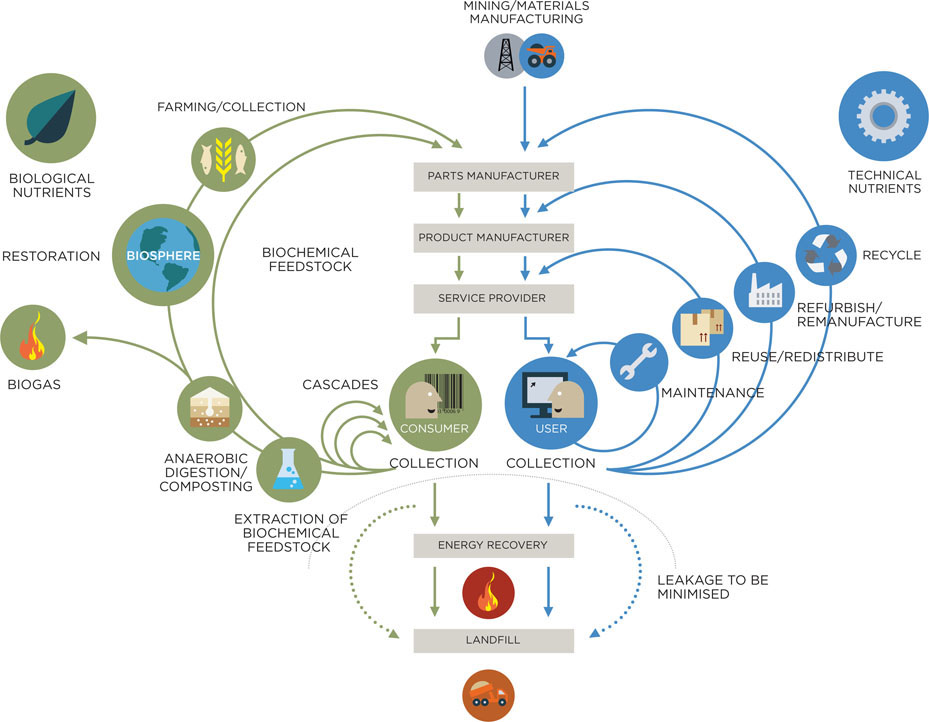
84. Diagram of biological and technical nutrient flows by the Ellen MacArthur Foundation created with the support of McKinsey & Company and adapted from the Cradle to Cradle Design Protocol by McDonough and Braungart
Combine materials in the right way
McDonough and Braungart describe certain products as ‘monstrous hybrids’. These are mixtures of materials or assemblies of components from which it is not economically feasible to recycle or salvage the raw materials after their current life. One very common example from the construction industry is composite floor decks, where concrete is poured into profiled steel sheets that are so intricately textured that it is unlikely ever to be practicable to separate the two materials. The second is double-glazed units. The glass is often given a low-emissivity coating (which would contaminate the glass production process if recycled) and then bonded with butyl, silicone, aluminium and desiccants – again confounding economic attempts at recovery of those resources in the future. The aim should be to assemble materials in a way that allows easy separation at end of life.
Design ‘Cradle to Cradle’
McDonough and Braungart set out to achieve ‘100% good’. Their vision is to completely eliminate the concept of waste by following the principles of natural systems and keeping all materials in one of two cycles: ‘biological’ or ‘technical’ (fig. 84). In the biological cycle, which includes natural fibres, wood, etc., all the materials are grown and used in such a way that they can be fully biodegraded at the end of their tenure as a product, reabsorbed into nature and become nutrients for growing other materials. The technical cycle includes all metals and minerals, which, once they have been mined and refined, should remain permanently in the system.
McDonough and Braungart describe cases mainly from the fields of industrial design and product design. We will now look at how the principles described in Cradle to Cradle can be extended to construction materials and combined with biomimicry to deliver ‘100% good’ solutions. In Chapter 3 we will discuss how both of these cycles need to be backed up by information cycles.
Technical cycle solutions
Concrete
Concrete is the universal material of our age. Globally, 15 billion tonnes are poured every year and this is set to continue as less developed nations create the buildings and infrastructure necessary for a decent quality of life. Cement presents a problem in that it prevents full re-involvement in the technical cycle. Consequently, aggregates become steadily downcycled. There may be opportunities with geo-polymer cements to create a form of concrete that can be safely reabsorbed into the lithosphere. Similarly, pozzolanic cements and the naturally occurring cementitious compounds that bind together conglomerate rocks could offer good solutions.
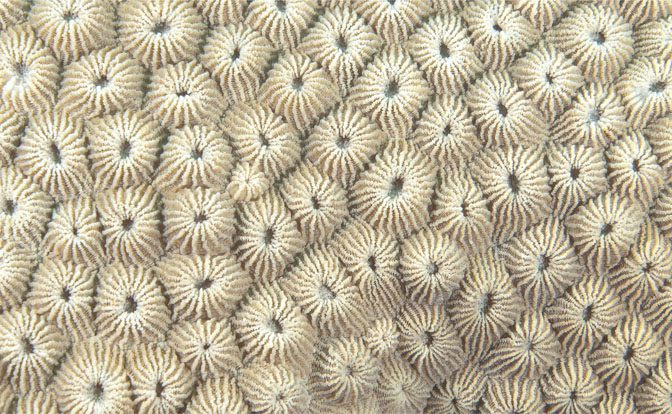
85.
Could we master the process of biomineralisation as performed by corals and other marine organisms? If so, the concrete industry could sequester carbon in large quantities
Recent developments led by Brent Constantz suggest that we are on the brink of achieving what corals and other marine organisms have been doing for aeons: creating mineral structures that absorb rather than release carbon in production. Constantz is an expert in both biological and geological mineralisation and, while at Calera, developed a process for cement manufacturing that is equivalent to the biological version. Biomineralisation sequesters an atom of carbon with every atom of calcium in the process of forming calcium carbonate (fig. 85). Cement production, by contrast, releases a molecule of carbon dioxide for every atom of calcium. Since leaving Calera, Constantz has focused his attention on creating carbon-positive88 aggregates, which have the potential for faster deployment and greater gains in terms of carbon sequestration. If we contemplate the amount of concrete that is still to be used in developing nations like China and India, then it is clear how significant it would be if that concrete were removing carbon from the atmosphere rather than adding to it.89 This is one example of an emerging field of ‘drawdown technologies’ which could play a crucial role in mitigating climate change by reducing, and ultimately reversing, the build-up of atmospheric carbon dioxide.90
Glass
Glass is another ubiquitous material in contemporary construction. Graham Dodd from Arup has proposed that one way of manufacturing C2C double-glazed units would be to create spectrally selective glass based on biomimicry. Many colour effects in nature, such as the iridescent wings of the blue Morpho butterfly (fig. 86), are achieved not through pigments or coatings but through ‘structural colour’, which is a microstructure that refracts and scatters light rather than reflects it. For glass, it might therefore be possible to create a nanostructure from the glass itself that could perform in a similar way to the low-emissivity coatings currently applied as a separate material.
The other form of ‘monstrous hybridity’ in glazing can be addressed by a thermoplastic seal that is easier to remove and recycle. The thermal performance of this unit would probably not match conventional ones, but it is important to remember that reducing energy use and related carbon emissions, while extremely important, is not the only challenge we have to address. We may find that some of the most comprehensively sustainable solutions are not necessarily the lowest-carbon options.
Metals and finishes

86.
The iridescent colour of the blue Morpho butterfly is the result of a microstructure that creates a colour effect through refraction, rather than a pigment that reflects particular wavelengths of light
Many standard materials in the built environment are finished with paints, seals and other coatings, which can reduce the materials’ reusability or recyclability. Such coatings are inherently problematic because they are almost certain to end up as pollution. Biological materials are able to repair themselves, whereas our construction materials are inert and, with a few exceptions discussed earlier in this chapter, are likely to remain that way for the near future. In current practice, it is best to promote increasing use of metals that are inherently resistant to weathering, such as aluminium, stainless steel and Corten steel. We can also harness significant advances in technology, such as foamed metals and honeycomb forms, that achieve remarkable increases in resource efficiency. We may find other applications of biological colour creation in products for which we currently use paint coatings.
Composites and their consequences
One of the most problematic classes of materials from a C2C perspective is synthetic composites, such as fibreglass, which combine a fibre with a resin in a way that makes it effectively impossible to recycle. One project that explored an alternative to fibreglass was the Plastiki Expedition, initiated by David de Rothschild. The aim was to design a boat made out of plastic bottles that could be sailed across the Pacific on an expedition that would highlight the problems facing the oceans as well as the kind of solutions that we need to implement. He focused particularly on the two vast areas of floating waste, located in the gyres formed by ocean currents, known as the Pacific garbage patches.
Each of these is the size of Texas and consists mainly of plastic, either in bulk form (which affects seabirds and marine mammals) or as UV-degraded microscopic lengths of polymer, which absorb other pollutants and accelerate their uptake into the marine food chain. Those at the top of the food chain are particularly badly affected, including Inuit mothers who are advised not to breastfeed their children because the level of toxins is sufficient for their milk to be classified as hazardous waste. Similarly to the alarming issue of declining sperm count, this shows how dramatically the quality of our lives is affected by our relationship with materials.91

87.
Concept sketch of the Plastiki Expedition boat, showing boat hulls made from large bundles of bottles
Working with Exploration as concept architects, the first challenge was to turn a very weak material – plastic bottles – into a structure that would withstand the forces likely to be experienced on a voyage through the Pacific Ocean (fig. 87). The team took inspiration from a number of examples in nature of close-packing and of hydrostatically pressurised cells. This included pomegranates, which consist of a large number of individual segments packed together in a tight geometrical way. This led to a significant breakthrough in the design process: the idea of pressurising each bottle with air – a simple move that transformed the bottles into incredibly solid objects. Tests proved that, just by adding air pressure, it was possible for two plastic bottles on end to support the weight of a car.
While bundles of bottles provided useful buoyancy, there had to be a core material to act as a frame. The team discovered a sheet material called SrPET (self-reinforced polyethylene terephthalate) that had recently been developed from waste plastic bottles. The revolutionary aspect of this product was that it was made entirely out of one material (PET – polyethylene terephthalate) but in two different forms: a fibre and a matrix. At a molecular level, the fibres are chains of aligned polymers, while the matrix is a spaghetti-like tangle of polymers. The structural effect is very similar to the phenomenal toughness of fibreglass but, unlike fibreglass, SrPET can be recycled indefinitely with no loss of resources or material quality – the holy grail of C2C design. In fact, the possibility existed to upcycle the bottles and SrPET into products with higher value, such as fleece sweaters that could be auctioned off for charity, further raising the profile of the environmental problem while offering a solution. The Plastiki boat completed its voyage across the Pacific in July 2010 and its broader mission, to demonstrate material solutions to environmental problems, was described in a documentary film.92
Biological cycle solutions
Timber
Similar challenges regarding coatings apply to timber as they do to metals: current paint and preservative finishes will invariably end up as pollution. Using cellulose in 3D printing is perhaps the most revolutionary way to rethink wood but, in its conventional forms, timber is best selected either for its inherent resistance to weather (woods such as oak, larch and western red cedar) or by specifying products that use non-toxic treatments to extend the wood’s life, such as Thermowood® or Accoya®. The first of these uses a short but intense heat treatment to make the wood indigestible to microbes for an extended period, while Accoya® achieves much the same result through a process of acetylation, using a naturally occurring and benign chemical (acetic acid) that also stabilises moisture content. These options allow the timber to be returned to the biological cycle at the end of its useful life.
Rammed earth
Rammed earth has been used as a building material for centuries and has returned to favour owing to its extremely low environmental impact. Conventionally, it is rammed into formwork and it is worth studying how earth is used by various animal builders, who have to make do without power tools. The muddauber wasp (Trigonopsis) selects mud of the right consistency and moisture content, holds a pellet against the wall it is building and then exploits the thixotropy of the mud by vibrating its abdomen.93 Thixotropy is the property of showing a reduction in viscosity when shaken and, for the wasp, it results in very efficient compaction with minimum force.94 Some birds create a composite material from mud by combining plant fibres that give the benefits of strength in tension as well as compression – similar to the function performed by steel rods in reinforced concrete. Italian company WASP, inspired by Trigonopsis, brought a 3D printer range onto the market that can use clay as the raw material. In 2015, they completed Big Delta, a clay printer large enough to print a house.95 For what is often regarded as a rather crude material, the results are striking (fig. 88). The other appealing aspect of this approach is that it allows us to get closer to the spirit of great builders like birds, mammals and insects that demonstrate what elegance can be achieved with materials that are readily available. We could do the same; instead of bringing materials to the site, we could bring ingenuity and create structures with a fraction of the embodied energy of conventional approaches. An extension of this ‘biomimicry technology plus local materials’ philosophy could be revolutionary for people living in rural areas.

88. 3D-printed ceramic by Olivier van Herpt showing the beauty and precision with which relatively crude materials like mud and clay can be assembled
Plastics
Plastics can be made out of plant resins and, if toxic additives or coatings are avoided, then the material can be returned to the soil as biological nutrients.96 One of the most interesting examples of this is a plastic developed by Javier Fernandez and Donald Ingber called ‘shrilk’ which combines certain properties of both shrimp shell and spider silk to create a composite that is strong, durable and biodegradable.97 An alternative option is that plastics are made from agricultural waste and then endlessly recycled. In the C2C model this would be an example of a material originating in the biological cycle and then being treated as part of the technical cycle. It is tempting to think that this could be another drawdown technology, but this aspiration needs to be tempered by the current reality that most crop production involves considerable quantities of oil-based fuels and agro-chemicals. Consequently, it would not make sense to grow plants specifically for the purposes of plastics production (it would be better to use oil to make plastics directly) but it would certainly be worth using agricultural waste. Another possibility, with huge drawdown potential, would be large-scale seaweed farming, which could produce both fertilisers and raw materials for bioplastics.
Adhesives
Nature has evolved intriguing solutions to adhesion, none of which involve toxins. Studies into the dry adhesion characteristics of geckos’ feet and the way that mussels attach themselves to rocks have led to a glue called ‘Geckel’. This innovative glue works on both wet and dry surfaces and is also reversible – handy when it comes to dismantling. Sandcastle worms (Phragmatopoma californica) have evolved a direct equivalent to two-part epoxy adhesive, which can set underwater in 30 seconds. The worms use it to build colonies of protective homes from fragments of shell and grains of sand, strong enough to withstand battering waves. Scientists at the University of California, Santa Barbara are working on an alternative to medical-grade cyanoacrylate (superglue) based on the sandcastle worm’s adhesive.
The biodegradability of biological adhesives is hugely advantageous from a C2C perspective because it allows many small elements to be assembled into, for instance, large panels, while still ensuring that all the materials can remain within the biological cycle. It is conceivable that we could make whole buildings by gluing together elements with the same elegance as the sandcastle worm (though it may be a while before commercial housebuilders take up the idea!).
Integrated approaches
Some of the most thorough explorations into biomimetic architecture in recent years have been carried out at the Institute for Computational Design (ICD), in collaboration with the Institute of Building Structures and Structural Design (ITKE) at the University of Stuttgart.98 Much of this work has emerged from the realisation that almost all load-bearing structures in biology are fibrous composites and their performance is substantially determined by the way in which the fibres are aligned. Interesting examples are to be found in arthropods, such as crustaceans and insects, which have exoskeletons made up of layers of bundled fibres in an arrangement similar to plywood (fig. 89).
Menges’ team built a lightweight Research Pavilion in 2013–14. They studied a wide range of different biological fibre-composite structures and settled on beetle wing covers (otherwise known as ‘elytra’ – the hardened forewings that protect the much more delicate flying wings) as offering the greatest combination of lightness and strength (fig. 90). The team’s research included scanning electron microscopy in order to develop detailed three-dimensional models of the fibre structure and alignment inside the elytra, guiding the design.
Mimicking a complex biological arrangement of fibres required the kind of techniques that have only recently become possible with the benefits of computational design and fabrication. A system was developed using two robots that wound resin-coated glass fibres together to form large-scale double-layer components without the need for a mould. Comprehensive analysis of the global structure informed the precise fibre layout at the local level.

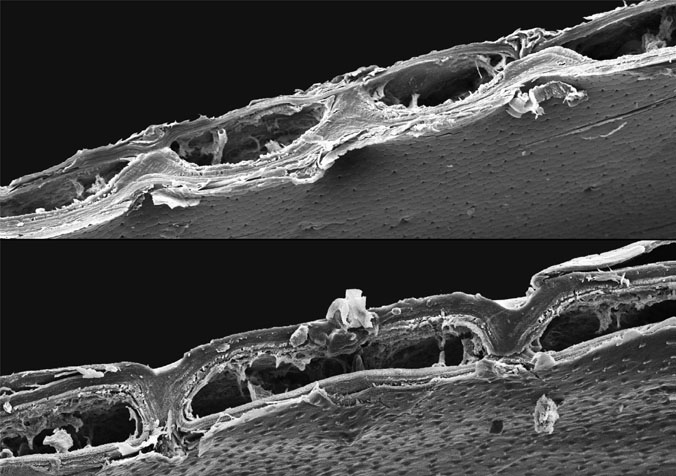
90. Beetle shells studied by Professor Achim Menges’ team during the design of the ICD/ITKE Research Pavilion
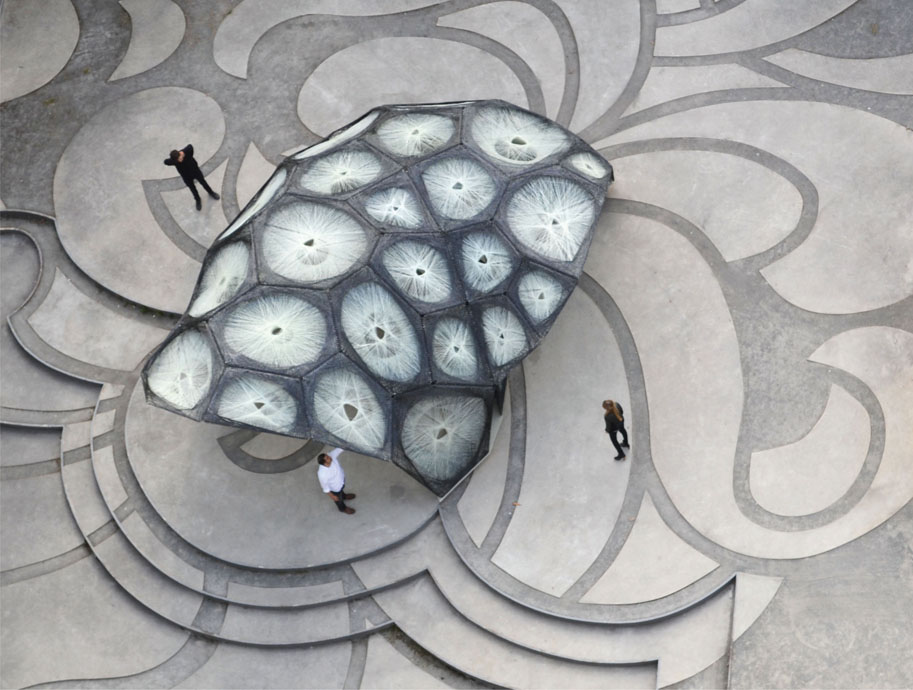
91.
The ICD/ITKE Research Pavilion at the University of Stuttgart, made from robotically woven fibres based on a detailed understanding of the morphology of beetle shells
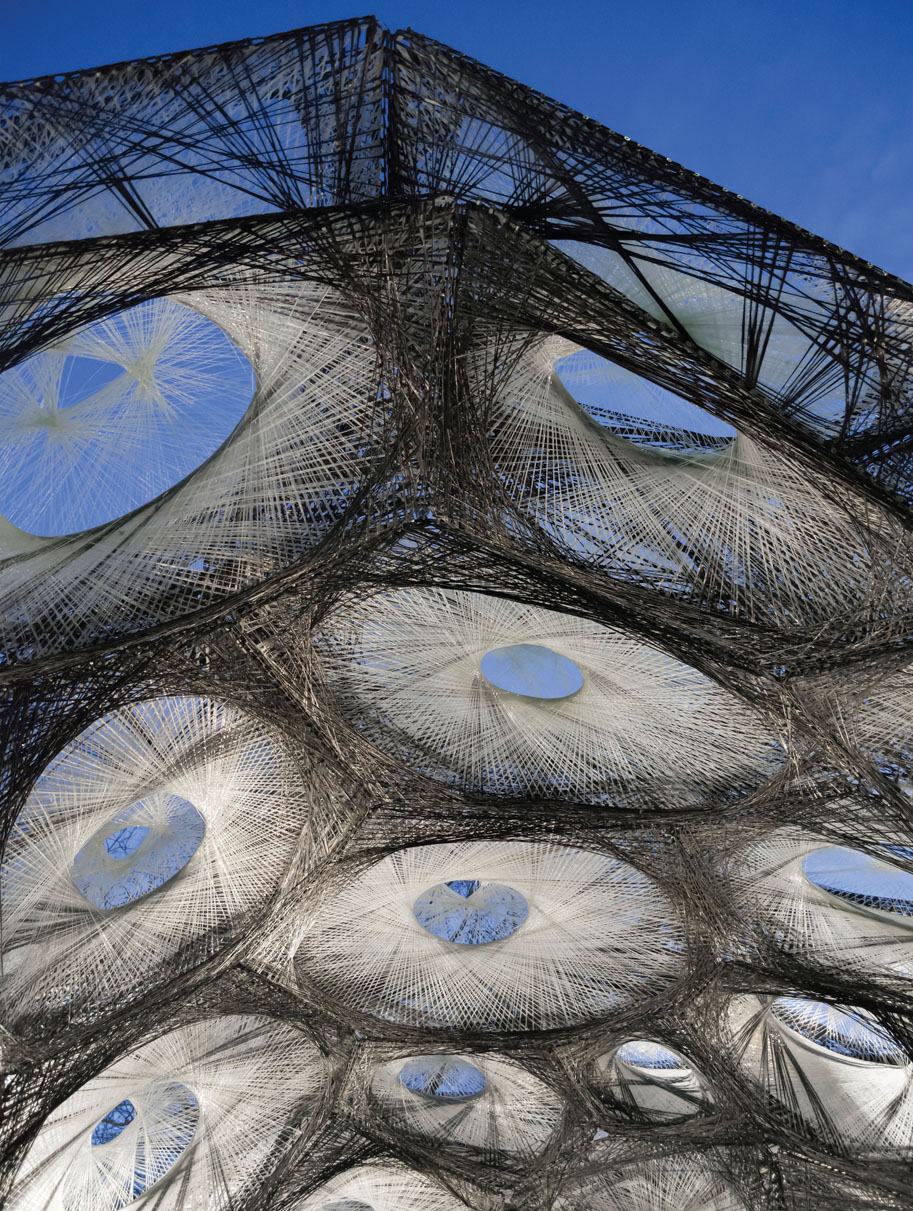
92. The ICD/ITKE Research Pavilion at the University of Stuttgart, made from robotically woven fibres based on a detailed understanding of the morphology of beetle shells
The result is a spectacular pavilion that shows what can be achieved from a deep dive into biomimetics (figs 91 & 92). A detailed understanding of biological material morphology has resulted in a generative design approach, innovative construction methods and a highly distinctive work of architecture. The weight of the pavilion works out to be less than 6 kg/m2 – a comfortable factor-10 saving over more conventional approaches – which gives a further example of the resource efficiency that could be delivered in future applications of biomimicry. Clearly, the project would form an even more satisfying conclusion to this chapter if, instead of resin-coated fibreglass, it was made from biological fibres or materials that follow C2C principles – but that development will hopefully emerge from the Institute’s ongoing work.
Conclusions
If we can steadily increase our use of biological raw materials and technical materials whose manufacturing absorbs rather than emits carbon dioxide, then, with these drawdown technologies, the construction industry can move into a new environmental paradigm that goes beyond mitigating negatives to deliver a positive and regenerative approach. While architecture faces the limits of what materials are available, science and bioengineering are pushing ahead with research and development: changes are under way. Computational design and fabrication are allowing us to edge steadily closer to the precisely structured materials found in biology. Applying the ‘more design, less material’ approach is becoming increasingly plausible.
It is readily conceivable that making construction elements using biological polymers in rapid manufacturing could achieve factor-100 savings in energy compared to conventional approaches.99
Providing a good quality of life for the likely future global population of nine billion will be far less challenging if such radical increases in resource efficiency can become commonplace.
It is promising that biomimicry doesn’t always need to rely on high technology. As we saw with the 3D clay printer, biomimetic approaches can be low tech – giving people the tools and solutions to transform locally available materials with the resource of human ingenuity. Similarly, Guastavino vaulting can be developed with straightforward biomimetic approaches to span further using basic materials (and less of them).
Where biomimicry can be a particularly powerful design tool is in identifying ideals towards which we can strive. The goals of growth by adaptive accretion, self-assembly, non-toxicity, self-repair and the many other characteristics of biological materials may not all be achievable within our current constraints but they are worthy aims that will deliver multiple benefits.
A biomimetic approach to materials can facilitate the shift from a linear, wasteful and polluting way of using resources to a closed-loop model – one of the essential transformations necessary to arrive at truly sustainable architecture and a good quality of life for all the world’s inhabitants.
Notions of closed-loop stewardship of resources and biomimetic manufacturing are inextricably linked, as Julian Vincent has neatly summarised:
Considering how nature makes things leads us to consider systems, and how we can rethink human-made systems to mimic the remarkable efficiencies of ecosystems.
